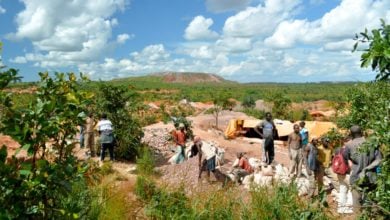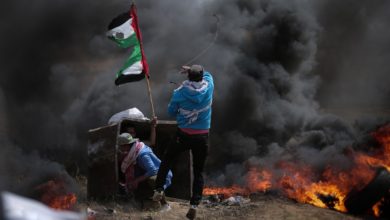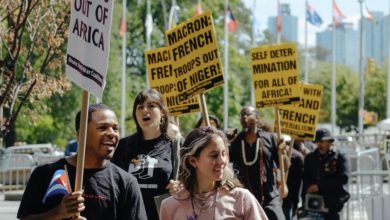It was a scene worthy of a yellowing front-page from South Africa’s old Rand Daily Mail newspaper, to be found behind glass in some museum exhibit: armored personnel carriers, heavily-armed police, the blood of miners. Instead, this was the scene at the Marikana platinum mine on Aug. 16, where South African police killed 34 striking miners in the deadliest police shooting since the fall of apartheid.
These brutal killings made front-page headlines across the world. Although aware of South African poverty and deprivation, many people were shocked to see so brutal an act carried out by a government led by an organization that had once heroically resisted the bestial conduct of apartheid racists. In a development as disturbing as the massacre itself, the striking miners—not the police—were charged with murder, although at least some of the charges have been withdrawn according to an announcement Sept. 2.
The massacre and the prosecutors’ actions have provided a wake-up call to the world, a terrible signal that social conditions in South Africa have polarized to an extreme. Poverty, unemployment and violence have become an absolute scourge, and the once heroic African National Congress has been complicit in maintaining these conditions. The Marikana murders are the ultimate confirmation that South Africa, while transcending apartheid, has yet to drive out the realities of capitalist inequality and exploitation.
‘The situation has been building up’
The Marikana mine is owned by major platinum producer Lonmin. An old South African mining company listed on the London Stock Exchange, Lonmin is notorious for its atrocious conditions and less than savory business practices. This reputation extended even into Westminster Palace, where British Prime Minister Edward Heath once referred to the company as the “unpleasant and unacceptable face of capitalism.”
As if to underscore the importance of the mining industry over the local population, Marikana is located in Bojanala Platinum District Municipality in South Africa’s Northwest province. Bojanala is home not just to Lonmin mines, but to several of the world’s richest platinum mines and largest mining conglomerates.
Despite this, unemployment is sky-high. One study relates that 16.75 percent of those in the “economically active” age-group are out of work. If you break that number down even further, the picture becomes worse: 43.8 percent of those age 20-29 are unemployed, while 27.5 percent aged 30-39 have no job.
Around 67 percent of the region lives on roughly $200 or less a month. In Rustenburg, the district seat, 41 percent of people live in what are delicately called “informal dwellings,” or more accurately, shacks. Thirty-five percent of adults in Bojanala are functionally illiterate and only 20 percent have completed a high school education. While the exact statistics are incomplete, Bojanala also has the dubious distinction of having the third-highest rate of HIV/AIDS transmission of any South African District.
Lonmin sponsors a school in Marikana for local children, a school at which researchers found many classrooms contaminated with asbestos. Lonmin keeps workers in a precarious state of employment; in 2011, the company sacked 9,000 workers who had gone on strike for better conditions. Further, Lonmin is known to employ contract and immigrant workers who lack certain labor protections.
While Lonmin is a creation of white capitalists, it was one of the first companies to open itself up to some Black ownership, and key ANC cadre and billionaire Cyril Ramaphosa is a shareholder. Others like Ramaphosa, who himself is a former mineworkers’ union leader, also hold shares, either individually or through the Shanduka Group, an investment company Ramaphosa founded. Lonmin as a result has close ties to the ANC-led government.
It is in this context that the Marikana massacre occurred. Mining bosses from the major companies have for decades tried to break the power of organized workers, frequently using contracted labor to defeat strikes and weaken the unions. The National Union of Mineworkers, the main mineworkers’ union, had negotiated a number of contracts and viewed itself as the primary representative of miners.
Workers unhappy with NUM
Significant contingents of workers, however, have been unhappy with NUM negotiating tactics and resulting contracts. They believe that the union failed to push for higher salaries because of its ties to the government, which in their view is in bed with the Lonmin bosses. Out of this discontent has come the growth of a new union, the Association of Mineworkers and Construction Union.
For their part, the NUM and South African Communist Party maintain that AMCU is funded by the mine bosses in order to foment unrest in the mine regions and ultimately undermine a unified workers’ struggle for better conditions. These are strong accusations, and it is not clear where the truth lies. However, it has been a strategy of South African capitalism to attempt to sow discord amongst Blacks with false-flag organizations.
Regardless, on Aug. 16 a large gathering of workers came to protest the horrible conditions in and around the mines. The workers were armed but did not have firearms and protested vigorously. The police opened fire with live ammunition in order to break up the protest. After this, it is not clear what happened. Some reports have said miners were corralled by police, then fired on. Others say that the miners rushed a police line.
In any case, the police had guns and armored vehicles, and rather than using so-called “non-lethal” ammunition, fired live rounds. This was a massacre. Whether or not it was whipped up by agent provocateurs is secondary to this fact. The South African police acted like their counterparts around the world, attempting to control a people’s movement and then striking with lethal force when it moved out of their control.
Whither the left?
The SACP and the major union federation COSATU, have essentially backed the police version of events. While deploring the killings, they have directed their fire at the AMCU, which they view as a boss-sponsored, anarchistic sower of division. Their view is that the police were provoked. If the AMCU or any other force deliberately led workers into a situation hoping for a massacre, they of course deserve condemnation.
But, first and foremost in this situation, the police must be condemned. Although the South African government is led by an organization with a revolutionary heritage, the use of state power against these miners shows which social class wields power. To accept or rationalize the police killing is to legitimate the right of the capitalist state to attack and kill workers whenever it claims it feels “threatened.” The reaction of the SACP and COSATU, the two giants of the South African left with long and heroic histories, is disconcerting, to say the least. It also opens the door for opportunistic and demagogic forces to take advantage of the workers’ righteous anger.
What’s next?
Lonmin stands as a symbol of the deep social polarization in South Africa. Poverty and deprivation have reached desperate levels, and the feeling of promise that came with the end of apartheid has all but faded. The massacre raises a series of issues about South Africa today—the political economy of post-apartheid South Africa, the role of the traditional left organizations, and the political balance of forces and prospects for the future. The Lonmin disaster should not be viewed as an isolated incident but one that causes us to take historical stock of the struggle in South Africa and its lessons for revolutionaries worldwide.
This is the first in a series of articles that will further analyze these issues.





